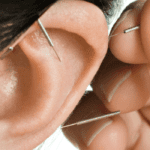Migraines and severe, recurring headaches affect over 12 million Americans.
The widespread prevalence of migraines has resulted in many effective treatment options. Most people try medications that have side effects at first. However, other options can help with migraines, like dry needling for migraines. It’s similar to acupuncture but with a Western approach.
Let’s discuss how dry needling for headaches and migraines can help you find relief.
What is Migraine?
Migraines are severe headaches that cause severe throbbing pain or pulsing sensation. Usually, it affects one side of the skull, but it can spread to the entire head. They’re also accompanied by severe nausea and sensitivity to lights and sounds. They may also last from hours to days, keeping you from doing the things you need to do.
Some people have an aura, a warning symptom that occurs before or after a headache. It can be visual disturbances like flashes and blind spots, tingling in one arm, or difficulty speaking.
Triggers
Migraine has many triggers, like:
-
Drinks that have alcohol or caffeine
-
Stress
-
Weather changes
-
Hormonal changes in women
-
Sensory stimuli
-
Physical exertions
-
Medications
-
Changes in sleep patterns
-
Foods and food additives
Causes
The causes of migraines are not fully understood, but it’s clear that genetics and environmental factors are involved.
There might be changes in the brainstem or trigeminal nerve interactions or imbalances in the brain’s chemistry involved in pain regulation.
Complications
Painkillers are often the first thing patients grab when they experience migraines. However, too many painkillers can cause medication-overuse headaches that increase with aspirin, acetaminophen, and other medications with caffeine for more than a few days a month. They occur when the medications stop relieving pain and begin to cause headaches, prompting patients to take more pain medications that continue this painful cycle.
Dry Needling for Migraines
As you can see, medications might not be the best way to manage migraines in the long term. One of the best things you can try is to look for alternative ways to find relief from pain, like dry needling.
What is dry needling for migraines? Dry needling, or trigger-point dry needling, is a pain management technique designed to ease pain and facilitate healing. It targets trigger points formed when muscles become tight from trauma, overuse, or lack thereof.
Trigger points found in the upper back may radiate severe pain to the head, causing headaches and migraines. Specialists generally insert fine needles into the trigger points to relieve the radiating pain they cause. Inserting these needles stimulates the tissues and releases the tension at the trigger point. Combining it with physical therapy, exercises, and medications may help relieve migraine pain.
However, dry needling for migraines has side effects like bleeding and bruising. It’s also not suitable for pregnant women and those with a fear of needles.
Dry needling for migraines reviews like this one published in 2021 state that dry needling provides short-term headache pain relief similar to other treatments and improves related disabilities in the short term.
Other Migraine Management Techniques to Try
Aside from dry needling for migraines, you can also naturally manage migraine in other ways, including:
-
Give acupuncture a try.
Acupuncture is a traditional Chinese treatment that uses thin needles inserted into specific parts of the skin to treat various conditions, similar to dry needling for migraines.
A 2016 review of 22 studies found moderate evidence that acupuncture reduces headache symptoms. The authors state that people who had migraines for six days a month before the treatment would likely have five days of regular care, four days of fake acupuncture or anti-inflammatory medications, and three and a half days of real acupuncture.
-
Avoid migraine-triggering foods and drinks.
You can keep migraine attacks at bay with a proper diet and avoiding certain foods and drinks that may trigger your migraine, like:
-
Chocolates
-
Deli meats, bacon, and hot dogs have nitrates
-
Alcohol
-
Cheese that has tyramine like cheddar, blue cheese, parmesan, and swiss
-
Extremely cold foods
-
Foods with MSG or monosodium glutamate
-
Pickled foods
-
Processed foods
-
Cultured dairy products like buttermilk, yogurt, and sour cream
Caffeine is a debatable area, and it’s best to take it in moderation. Some people feel relief from taking small amounts of caffeine; some migraine medications also have caffeine. On the other hand, too much caffeine can cause migraine attacks, and you may feel severe caffeine withdrawal headaches.
Keeping a daily food diary can help you figure out what foods and drinks trigger your migraines; after all, not all people have the same migraine triggers. Keep track of everything you consume, and note how you feel afterward.
-
Get a good night’s rest.
The connection between sleep and migraine is still unclear, but research starting in 2016 found a link between migraine frequency and low sleep quality, with or without auras.
You can improve your sleep by avoiding caffeine late in the day, stimulating activities before bed, and going to bed at the same hour each night.
-
Try biofeedback.
Biofeedback is a method of relaxation that teaches you how to manage your stress response. Electrodes are placed on your skin to monitor physiological changes that occur with stress during the therapy session.
Your therapist also helps you manage stress through changes in your physiologic processes as feedback during a session.
A 2019 study found good evidence supporting the use of mind-body interventions like biofeedback and cognitive behavioral therapy to treat migraines. These therapies have no side effects and are excellent alternatives to medication.
-
Learn and apply stress management techniques.
Stress management may also help reduce migraine frequencies. Some of the common stress management techniques include:
-
Mental imagery
-
Meditation
-
Deep breathing exercises
-
Counseling
-
Music therapy
-
Time management
-
Progressive muscle relaxation
-
Do some yoga.
Yoga promotes health and well-being through breathing, meditation, and body postures. A 2015 study showed that yoga could reduce the intensity, frequency, and duration of migraine attacks. It also helps reduce anxiety, improves blood flow, and relieves tension in migraine trigger areas.
-
Drink lots of water.
The American Migraine Foundation reports that about a third of migraine patients cite dehydration as a trigger.
Drinking plenty of water throughout the day helps prevent dehydration, particularly when exercising. You may also need to drink more water on hot days.
Key Takeaway
Migraines affect around 12 million Americans, and their cause is still unknown. Most patients first turn to medications. However, using too much may result in medication overuse headaches that make things worse.
Can dry needling cause migraines? No. In fact, it’s one of the best alternatives to migraine medications. Aside from dry needling, you can also try other natural ways to keep migraines at bay.
Find pain relief with Advanced Chiropractors Group.
Migraines shouldn’t prevent you from doing what you need to and make things more difficult. Our partner chiropractors in Largo, FL, offer dry needling for migraines and other modalities like massage and acupuncture to relieve migraines and headaches. Contact us today, and we’ll connect them to you as soon as possible.








